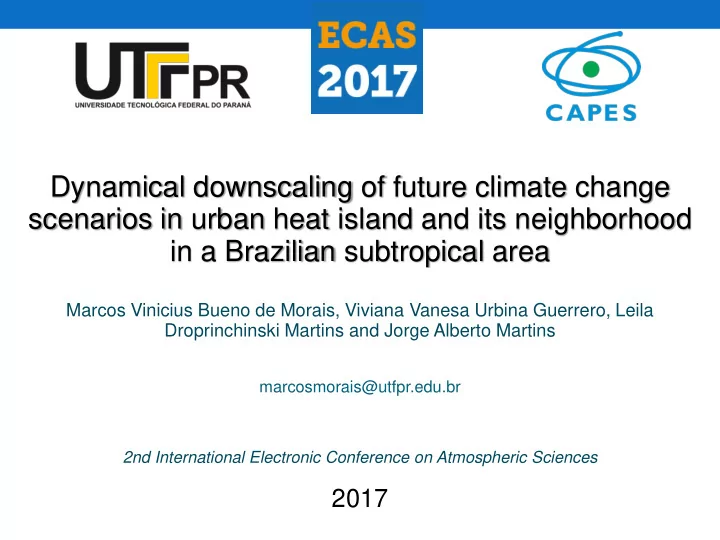

Dynamical downscaling of future climate change scenarios in urban heat island and its neighborhood in a Brazilian subtropical area Marcos Vinicius Bueno de Morais, Viviana Vanesa Urbina Guerrero, Leila Droprinchinski Martins and Jorge Alberto Martins marcosmorais@utfpr.edu.br 2nd International Electronic Conference on Atmospheric Sciences 2017
Introduction 50% of world population lives in urban areas. And this number is predict to grow From UN Report (2012)
Introduction Extreme events in urban areas 2003 heat wave on the west Europe From Summer (2016)
Introduction Urban expansion and urban planning Projections Tokyo: increasing the temperature for 4 0 C Paris: 1.5 0 C depending on the exposure Reference, Spread and compact urban expansion projections (Lemonsu et al., 2015)
Introduction Urban Heat Island effect: This is a transient feature of urban areas where the air temperature near the surface of the city is higher than the temperature of the surrounding rural areas. From Oke (1982)
Introduction Londrina located in a subtropical region medium sized-city major urban and population growth in recent decades more than 500 thousands inhabitants • Daytime UHI intensity in Londrina is about 2 0 C for a summer period.
Introduction Objective To investigate the physics in the UHI formation and intensity on the most extremes future climate change scenarios from the IPCC, A2 and B1.
Methodology SRES (Special Report on Emission Scenarios - IPCC) describes a series of future scenarios based in different factors that can influence the emissions demography, technology and economy. These scenarios uses a variety of possibilities based on global development, CO 2 sources and sinks, greenhouses gases alternative sources of energy soil land use changes
Methodology In this work, opposite scenarios: A2: pessimist B1: optimist From Nakicenovic (2000)
Methodology Numerical Modeling: Weather Research and Forecast atmospheric model (WRF - Version 3.6.1) three nesting grids horizontal homogeneous spacing grid (9, 3 and 1 km) centered in Londrina city (-23.3 0 , -51.1 0 ) from July, 21 th to July 25 th , 2015 - winter period, with no clouds or rain condition (considered a projection for the IPCC climate scenarios)
Methodology Londrina Urban Area Physics Schemes Microphysics Kessler Scheme Cumulus Grell-Freitas Surface Layer MM5 Soil-Land Noah LSM Urban UCM Boundary Layer Yonsei Scheme Table 1 – Physical Parameterisation in Shortwave Radiation Dudhia WRF simulation Longwave Radiation RRTM
Results Evaluation of the model: Temperature and specific humidity at 2m. Two surface station for observational data 1. SIMEPAR (-23.36 0 , -51.1647 0 ) 2. METAR (-23.33 0 ,-51.14 0 )
Results SIMEPAR Temperature at 2 m Specific humidity at 2 m
Results METAR Temperature at 2 m Specific humidity at 2 m* *For METAR, the specific humidity was calculated from the dew point temperature and Clausius-Clapeyron equation.
Results 18 Z at 22 July – 2015 Δ T GFS = 0.5 o C Δ T SRESA2 = 1.0 o C Δ T SRESB1 = 2.0 o C SRESA2 SRESB1 The wind pattern: SRESB1: south wind SRESA2: west wind GFS: east wind GFS
Results 18 Z at 22 July – 2015 Urban Area q GFS = 9.0 g/kg SRESB1 SRESA2 q SRESA2 = 7.5 g/kg q SRESB1 = 5.5 g/kg GFS
Results Specific humidity difference Temperature difference SRESA2-GFS SRESB1-GFS
Discussions and Conclusion Considering evaluation indexes: temperature at 2 m GFS simulation SRESA2 simulation specific humidity at 2 m GFS simulation SRESA2 simulation SRESA2 closer to GFS than SRESB1. Ex.: peak of temperature at 22 th July at 15 Z temperature values from SRESA2 are closer to than SRESB1 temperature values.
Discussions and Conclusion UHI in Londrina urban area in SRESA2 was similar to GFS simulation SRESB1 drier than SRESA2/GFS → influence on the energy budget at surface, confirming the high intensity of the UHI for SRESB1 simulation. The decrease on humidity affects directly the formation and the intensity of UHI The higher value in SRESA2 affects the wind pattern at local scale Can influence pollutants dispersion. Greater convergence at urban area can configure a maintenance of high levels of poor air quality. The dynamical downscaling of future scenarios is an important tool to analyses the impact of it in a local scale.
Discussions and Conclusion Further research... to carry out future simulations (for 2020, 2030, 2040 and 2050), using future projections of urban land use and occupation based on the population and economic projections to study the evolution of UHI in Londrina city. Simulations using the chemical version of the model will also be performed based on projections of vehicle use and industrial emissions.
References UN Report, 2012b: World Urbanization Prospects, the 2011 Revision – Press Release. Avaiable in: http://esa.un.org/unup/pdf/WUP2011_Press-Release.pdf Summer, T., 2016: Global warming amplified death toll during 2003 European heat wave. Avaiable in: https://www.sciencenews.org/article/global-warming-amplified-death-toll-during- 2003-european-heat-wave Lemonsu, A., Viguié, V., Daniel, M., & Masson, V. (2015). Vulnerability to heat waves_Impact of urban expansion scenarios on urban heat island and heat stress in Paris. URBAN CLIMATE. http://doi.org/10.1016/j.uclim.2015.10.007 Oke, T.R., Boundary Layer Climates, 2nd edition. Cambridge, 1988, 435pp. Nakicenovic, N.; Alcamo, J.; Davis, G.; Vries, B.; Fenhann, J.; et al. Special Report on Emission Scenarios, Published for the Intergovernamental Panel on Climate Change. Cambridge University Press, 2000, 608 pp.
Recommend
More recommend